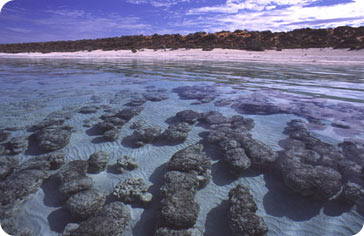The earliest life in the oceans wasn’t a fish or a mammal. It didn’t have a shell or tentacles. And instead of eating the other organisms around it, it made its own food from its environment. Yet without it, the complex life forms of today -- in the oceans and on land -- wouldn’t exist at all.
 Stromatolites found at Shark Bay in Western Australia. Credit: www.sharkbay.org © DEC / Kevin Crane
Stromatolites found at Shark Bay in Western Australia. Credit: www.sharkbay.org © DEC / Kevin CraneThe record of this early life is preserved in layered rocks known as stromatolites. They were built one tiny layer at a time by microbes -- the first life on Earth.
The microbes congregated in big mats in shallow waters, where there was abundant sunlight. They produced a sticky mucus that captured grains of sand and other solid particles. And as the microbes themselves died, they added calcium carbonate to the mix. Over time, this material became rock, often forming beds that are many feet thick.
The oldest stromatolites are about three and a half billion years old. Many others are more than one billion years old. But there aren’t nearly as many in more recent eras. That’s because as more complex life forms evolved, they fed on the mats of microbes.
The complex life forms were made possible in part by the microbes themselves. Just as many modern microbes do, they produced food by combining water, carbon dioxide, and sunlight. One of their waste products was oxygen. On the early Earth, the atmosphere was quite different from today’s, with almost no oxygen at all. The oxygen produced by these microbes transformed the atmosphere, making it hospitable to the life that inhabits the planet today -- including us.

